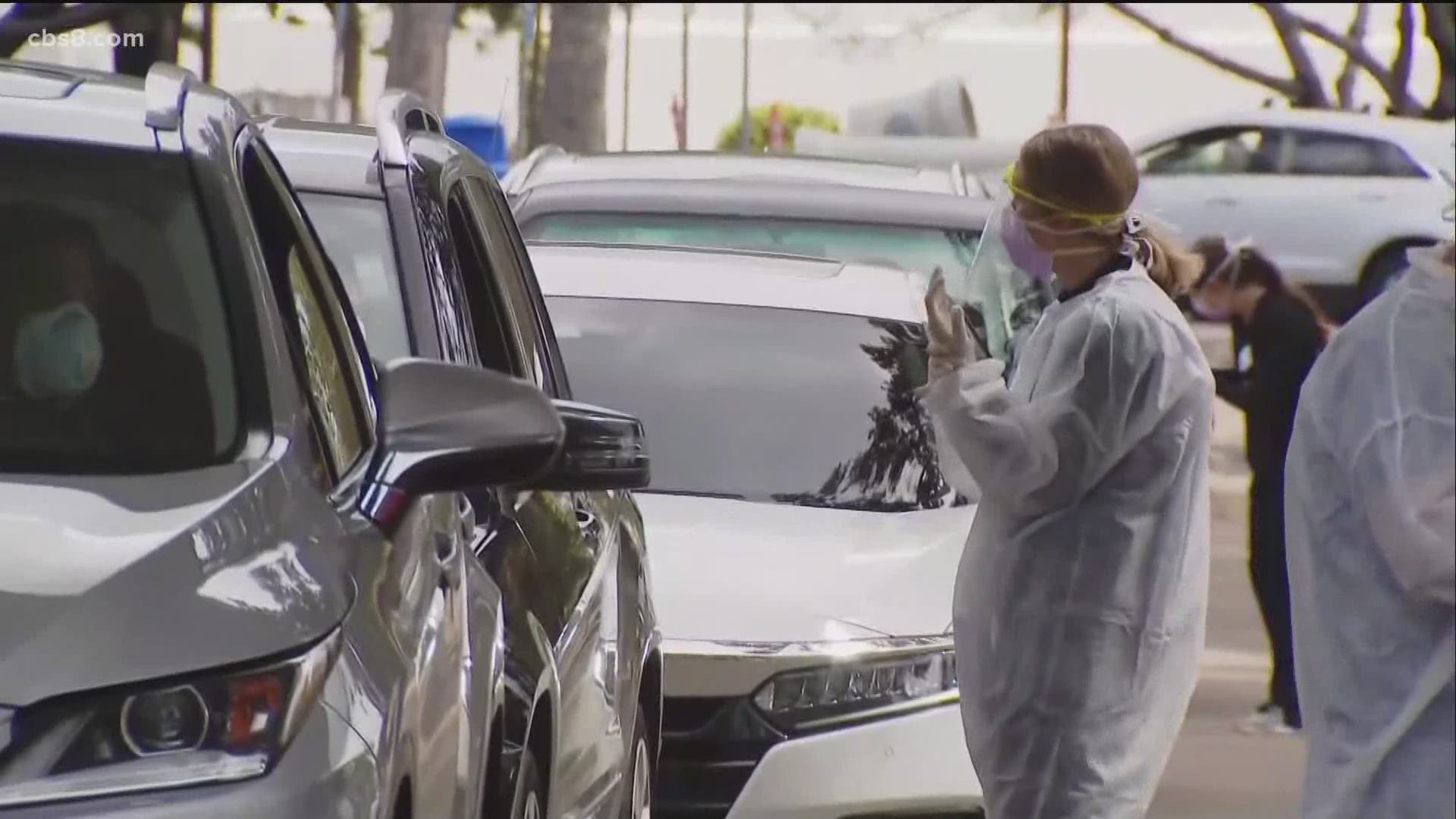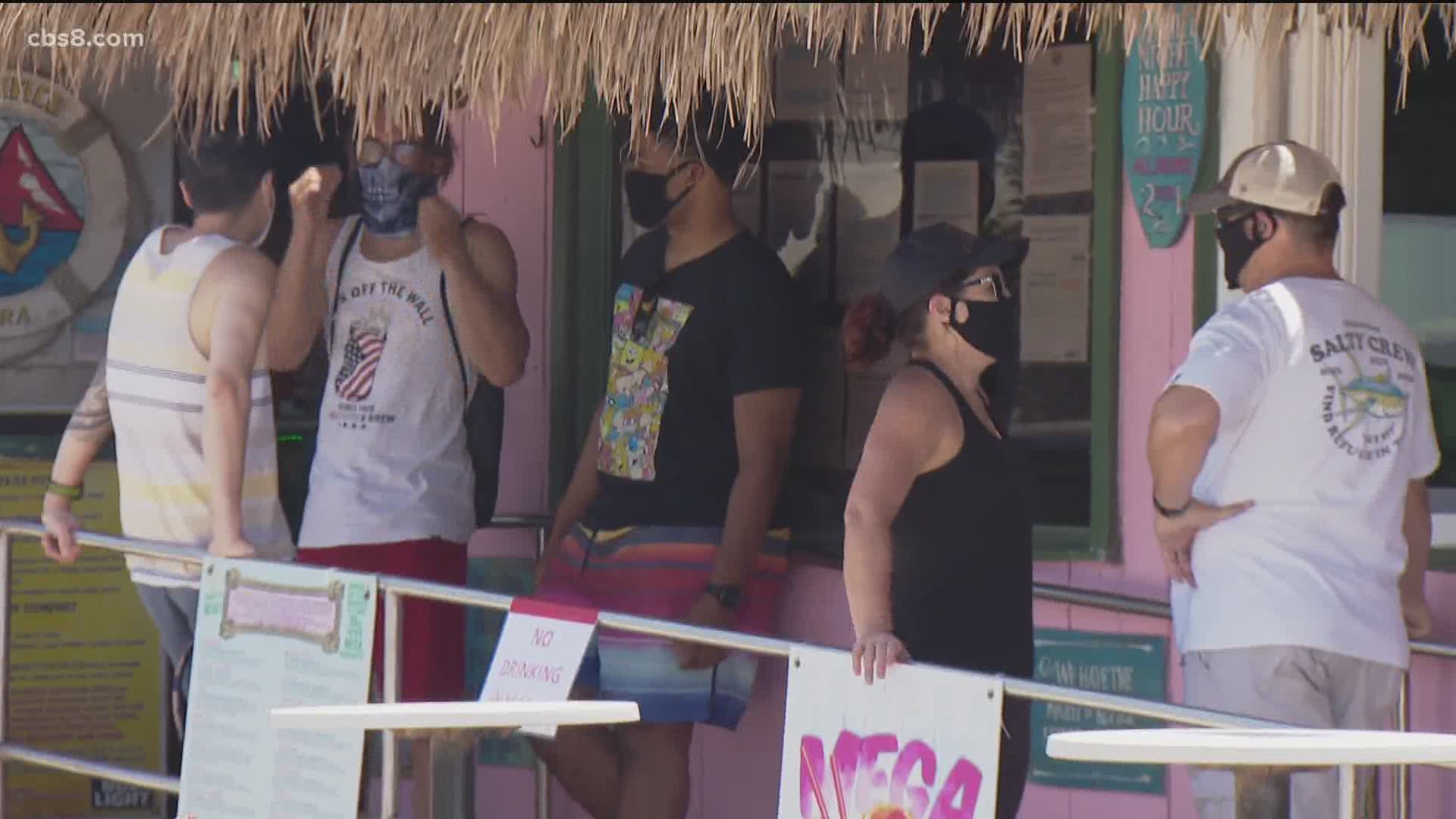SAN DIEGO COUNTY, Calif. — A record number of COVID-19 cases were reported Thursday, and the state has notified San Diego County it will be placed on its monitoring list July 3, which is expected to result in the county closing or placing new restrictions on additional businesses next week.
In the past three days, the rate of COVID-19 cases in the region went up from 103.8 to 112.8, surpassing the state’s threshold of no more than 100 cases per every 100,000 residents. Here’s how the rate is calculated.
Given the continuing high number of daily cases, it is expected that San Diego County will be on the state’s watchlist for the next three days and it could be forced to mandate more restrictive measures and additional closings based on guidance from the state.
Businesses on the state’s list should prepare to close or modify their operations since new restrictions could be effective as early as July 7 and would last for three weeks.
Indoor activities could be restricted on the following businesses:
- Dine-in restaurants (outdoor, pick up or drive-through can occur)
- Wineries and tasting rooms
- Movie theaters, family entertainment centers and cardrooms
- Museums and zoos
Also on Thursday, Governor Gavin Newsom urged Californians heading into the July Fourth weekend not to gather with people outside their households and to avoid crowds, as the statewide COVID-19 statistics continue to climb.
"We have now had a 56% increase in hospitalizations," Newsom said at a media briefing Thursday afternoon.
He also announced the roll-out of a new series of public service announcements designed to encourage everyone to follow the statewide mandate to wear a facial covering outside.
"The evidence is overwhelming: masks keep Californians healthy," he added.
San Diego County COVID-19 Triggers, Tests, Cases and Deaths
Community Outbreaks and Other Triggers:
San Diego County is monitoring 13 measures, or triggers, that could prompt revisions to the health order.
10 new outbreaks were reported July 2: eight in restaurants/bars, one in a grocery and one in a business.
In the past seven days, 22 community outbreaks were identified which represent 100 laboratory-confirmed cases.
The number of community outbreaks far exceeds the seven in seven days trigger.
A community outbreak is defined as three or more COVID-19 cases in a setting and in people of different households.
San Diego County also reached the case investigation trigger because only 67% of investigations were initiated within 24 hours of notification over a 7-day period. The percentage should be at least 71%.
Testing:
8,510 tests were reported to San Diego County July 1 and 7% were positive new cases.
The 14-day rolling average percentage of positive tests is 4.9%.
Cases:
A record 584 new cases were reported in San Diego County for a total of 15,207.
1,821 or 12% of cases have required hospitalization.
497 or 3.3% of all cases and 27.3% of hospitalized cases had to be admitted to an intensive care unit.
Deaths:
Five new COVID-19 deaths were reported for a regional total of 377.
Three men and two women died between June 26 and July 1, and their ages ranged from 51 to 93 years.
All had underlying medical conditions.
See below for recent commonly asked COVID-19 questions and their answers:
What happens when San Diego goes on the state watch list?
If San Diego remains on the watch list through July 5, then on July 6, the state can impose more restrictive measures for three weeks, at which point the cases are reassessed on July 27.
What restrictions could be coming?
On Wednesday, Gov. Newsom suspended indoor dining, entertainment venues (such as movie theaters, bowling alleys and arcades), indoor wineries and bars. Restaurants were permitted to remain open for pick-up, delivery or outdoor dining.
San Diego already ordered bars and some indoor establishments to close after other Southern California counties were forced to do the same.
Why aren’t beaches or outdoor venues forced to closed?
The Health and Human Services Agency says its tracers have linked all outbreaks to indoor facilities, including events inside people’s homes. No outbreaks have been linked to outdoor activities, such as the beach or recent protests.
How are people getting infected?
UC San Diego Health said in most cases transmission is occurring when people around them are asymptomatic and not physically distancing, which is why it remains imperative to wear a face covering and practice good hygiene.
Celebrate Fourth of July Safely
As residents prepare to celebrate the Fourth of July holiday, they should do it safely by not gathering in groups and staying with people in their own household.
Outdoor picnics and barbecues should take place only with household members to prevent the spread of the virus, and they should take place at home or close to home
When outside the home, San Diegans should do the following to protect themselves and others:
- Practice good hand hygiene and sanitation
- Keep six feet apart
- Wear a face covering
- Avoid crowded places
- Stay home if they are sick


